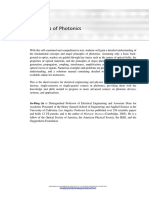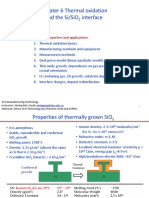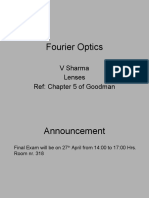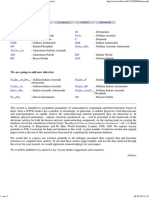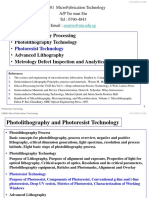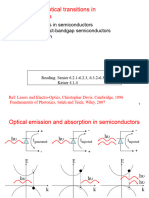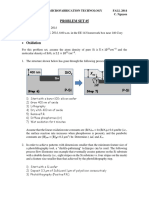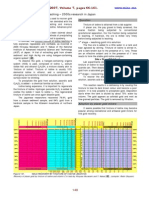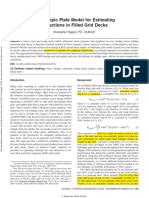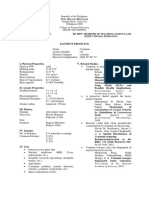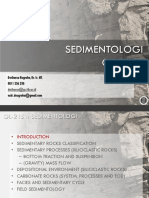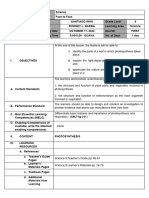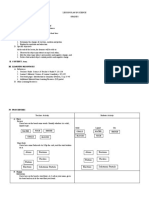100%(1)100% found this document useful (1 vote)
475 viewsPhysics of Thin Films
This document provides an overview of thin film physics and the structure of thin films. It discusses that thin films are less than 1 micron thick and are made up of a layer deposited on a substrate. The key applications of thin films include microelectronics, magnetic sensors, optics, and corrosion protection. Thin films can have different properties than bulk materials due to effects like stress, defects, and surface/interface influences. The document then goes on to describe the typical process for making thin films, including emission of particles from a source, transport to the substrate, and particle condensation. It also discusses the physics involved, such as thermodynamics, kinetics, solid state physics, and mechanics.
Uploaded by
daljotCopyright
© Attribution Non-Commercial (BY-NC)
Available Formats
Download as PDF, TXT or read online on Scribd
100%(1)100% found this document useful (1 vote)
475 viewsPhysics of Thin Films
This document provides an overview of thin film physics and the structure of thin films. It discusses that thin films are less than 1 micron thick and are made up of a layer deposited on a substrate. The key applications of thin films include microelectronics, magnetic sensors, optics, and corrosion protection. Thin films can have different properties than bulk materials due to effects like stress, defects, and surface/interface influences. The document then goes on to describe the typical process for making thin films, including emission of particles from a source, transport to the substrate, and particle condensation. It also discusses the physics involved, such as thermodynamics, kinetics, solid state physics, and mechanics.
Uploaded by
daljotCopyright
© Attribution Non-Commercial (BY-NC)
Available Formats
Download as PDF, TXT or read online on Scribd
You are on page 1/ 122
Physics of Thin Films
PES 449 / PHYS 549
Introduction and Overview
Ohring: Historical Perspective p. xix
What is a "thin film" ?
thin = less than about one micron ( 10,000 Angstroms, 1000 nm)
film = layer of material on a substrate
(if no substrate, it is a "foil")
Applications:
- microelectronics - electrical conductors, electrical barriers, diffusion barriers . . .
- magnetic sensors - sense I, B or changes in them
- gas sensors, SAW devices
- tailored materials - layer very thin films to develop materials with new properties
- optics - anti-reflection coatings
- corrosion protection
- wear resistance
- etc.
Special Properties of Thin Films:
different from bulk materials
Thin films may be:
- not fully dense
- under stress
- different defect structures from bulk
- quasi - two dimensional (very thin films)
- strongly influenced by surface and interface effects
This will change electrical, magnetic, optical, thermal, and mechanical properties.
Typical steps in making thin films:
1. emission of particles from source ( heat, high voltage . . .)
2. transport of particles to substrate (free vs. directed)
3. condensation of particles on substrate (how do they condense ?)
Simple model:
How do the variables effect film structure and properties ?
What physics is in all this ?
- thermodynamics and kinetics
o phase transition - gas condenses to solid
o nucleation
o growth kinetics
o activated processes
desorption
diffusion
o allowed processes and allowed phases
- solid state physics
o crystallography
o defects
o bonding
- electricity and magnetism
o optics
o conductivity - resistivity
o magnetic properties
- mechanics
o stresses in films
o friction and wear
Physics of Thin Films
PES 449 / PHYS 549
Structure of Solids: ideal solids
Ohring: Chapter 1, Section 1.2
Classify solids
- crystalline
o atoms show short and long range order
- amorphous (non-crystalline)
o atoms show short range order only
We will study crystalline solids first.
Crystal structure
crystals have two parts
1. lattice - regular periodic array of points in space
2. basis - a group of atoms located at each point in the lattice
lattices:
in three dimensions: only 14 unique lattices (Bravais lattices)
examples: (NOTE: the spheres are just points in space - NOT atoms !)
lattice parameter = a
o
= length of a cube side
see Figure 1-1 for other lattices
basis:
number and arrangement of atoms we put at each lattice point
examples:
- Cr
o bcc lattice
o one Cr atom basis
o a
o
= 2.88 Angstroms
- Cu
o fcc lattice
o one Cu atom basis
o a
o
= 3.615 Angstroms
- Si
o fcc lattice
o two Si atom basis
one Si atom at (0,0,0)
other Si atom at (1/4, 1/4, 1/4)a
o a
o
= 5.43 Angstroms
Surfaces
For thin films, we are interested in surfaces.
=> cut crystals in different ways.
Describe surfaces by Miller indices.
General Procedure Specific Example
1. Cut crystal along some
plane.
cut along a face of a cube
2. Determine x, y, z, intercepts
(x
o
, y
o
, z
o
)
(1, infinity, infinity)
3. Take reciprocals and reduce
to smallest integer.
(100) plane
[if we had used the (200) plane, reduce to (100)]
See Figure 1-3 for other examples.
Other cubic surfaces:
What would these surfaces look like ?
Note how open some surfaces are packed and how dense others are packed.
Different surfaces have different arrangements of atoms => different properties.
[crystal models demonstration]
Close packed planes:
Two surfaces produce the maximum possible density for packing spheres. The surface layers and
second layers of atoms are identical, but the positions of atoms in the third planes are different.
- hcp (0001) = base plane of the hexagonal close packed structure
o ABABAB repeat pattern
- fcc (111) = diagonal cut through the face centered cubic sructure (shown above)
o ABCABCABC repeat pattern
[see handout figures]
Crystal Directions
define a vector [h k l] between two lattice points
when the direction is negative, instead of a minus sign, use a bar over the number.
angle (o) between any two vectors [h
1
k
1
l
1
] and [h
2
k
2
l
2
] :
for cubic lattices:
- [h k l] is normal vector to (h k l) plane
- spacing (d) between (hkl) planes is given by:
where a
o
is the length of one side of the cube face
example: spacing between (100) planes in a simple cubic lattice:
Non-crytalline (amorphous) solids
glasses
not stable state for most pure metals
can be formed by very rapid cooling (10
6
K/sec)
readily formed from many metal alloys, semiconductors, oxides - especially at low temperatures
generally less dense than crystalline materials
no crystalline defects since no crystal structure
Physics of Thin Films
PES 449 / PHYS 549
Structure of Solids: defects in solids
Ohring: Chapter 1, Section 1.3
Classification of Defects in Crystalline solids
polycrystalline solid - contains several crystalline regions which are randomly oriented
Most crystalline materials have many defects.
Some (like Silicon) can be grown with relatively few defects.
Three types of defects:
1. Planar defects - grain boundaries
interfaces between two single crystal regions of different orientation
atoms at grain boundaries tend to be loosely bound
=> more reactive (corrosion) and accelerated diffusion along grain boundaries
typical grain sizes: 0.01 m - 100 m (micron)
How many atoms in a solid are at grain boundaries ?
rough model:
assume grains are all cubes with sides of length l
l = grain size
a = atomic lattice parameter
n = number of atoms in one row of the grain
then, l = na
What would be the result for spherical grains of diameter, l ?
A somewhat better argument using truncated octahedra leads to the fraction being about 3.35
(a/l). (See Christian "Theory of Transformations in Metals and Alloys", p. 332).
example:
for l = 0.1 micron (1000 Angstroms) and a = 3 Angstroms
about 10 atoms out of 1000 are at grain boundaries (1 %)
Number of grain boundaries in film (grain size) depends on deposition rate and substrate
temperature.
generally:
- lower T => smaller grains => many boundaries
- hight T => larger grains => fewer boundaries
grain size is often proportional to film thicknes
(thinner films tend to have smaller grains)
2. line defects - dislocations
example: edge dislocation - from inserting an extra row of atoms
distorts lattice => stresses (compression and tension)
very common: often 10
10
- 10
12
dislocations/ cm
2
in films
form from:
- film growth process
- dislocations in substrate continuing into film
- contamination on substrate
3. point defects
- self interstitial - extra atom
- vacancy - missing atom
- substitutional impurity - impurity atom in lattice
- interstitial impurity - impurity atom not in regular lattice site
in principle you can eliminate all of these except vacancies
vacancies arise from thermodynamics (entropy)
fraction of vacancies (f)
o
where k
B
= Boltzmann's constant = 1.381 x 10
-23
J/K
typically E
f
is about 1 eV
at room temperature, f is about 10
-17
point defects often arise from
- fast deposition
- low substrate temperatures
=> no time for atoms to move to crystal lattice sites
Surface Roughness
films always have some statitistical distribution of thickness across the film
in the worst case:
generally observed less roughness
Physics of Thin Films
PES 449 / PHYS 549
Structure of Solids: Bonds and electrons in solids
Ohring: Chapter 1, Section 1.4
Bonding in materials:
bonds lower the total energy of a system of atoms => solids are more stable than free atoms
bonds from electrostatic and quantum attraction and repulsion
electron structures around ion cores lead to different bond types and strengths
four basic types of bonds:
- metallic
o relatively weak bond (1 -2 eV)
o complicated mixture of electrostatic and quantum attraction and repulsion
o no direction to bonds
=> easy to deform
o examples: most metals, Fe, Ni, Cr . . .
- ionic
o strong bonds (2 -10 eV)
o Coulomb attraction of oppositely charged ions
o Coulomb and quantum repulsions
o no direction to bonds
o examples: NaCl, MgF
2
, ZnS
- covalent
o strong bonds (2- 10 eV)
o "sharing" of electrons
o bonds are directional
=> hard to deform
o examples: Si, Ge, GaAs
- Van der Waals
o weak bonds (around 0.2 eV)
o often neglected
o from distortion of electron clouds
o examples: inert gasses, organics
Bonds: attractive and repulsive components
all bonds have attractive and repulsive components
exact details of repulsive and attractive parts give:
- lattice parameters
- binding energy
- elastic modulus (from shape of well)
Surface bonds
surface atoms are less tightly bound than bulk atoms
Electrons in Solids
Metals:
some electrons bound to ion cores
other electrons are "free electrons" => conduction
| = work function = energy needed for electron to escape from metal
(important in thermionic emission, photoemission)
Insulators:
large gap between filled and empty states
=> electrons have no where to go => very poor conductors
Semiconductors:
similar to insulators except gap is smaller (around 1 eV)
=> can apply voltage or heat to excite electrons into conduction band
doped semiconductors create states in the gap => easier to excite electrons across gap
Physics of Thin Films
PES 449 / PHYS 549
Thermodynamics and Phase Diagrams
Ohring: Chapter 1, Section 1.5
Thermodynamics
tells us what can happen - - - not how fast it will happen
free energy change
G = G
final
- G
initial
= H - T S
where H = enthalpy change, T = temperature, S = entropy change
- G < 0 => process is allowed
- G > 0 => process is forbidden
- G = 0 => equilibrium
nature will minimize free energy
Chemical Reactions
aA + bB <=> cC
We can relate the free energy change for this reaction to the activity, a, (kind of concentration).
It can be shown:
where R = gas constant = 1.987 cal/(mole K)
note if a
i
> a
i(eq)
you have supersaturation
often G is about the same as G
o
which is the free energy change in standard state
example: Ellingham diagrams
oxide formation
if Al and Al
2
O
3
are in contact with Si and SiO
2
:
- Al will be oxidized to Al
2
O
3
- SiO
2
will be reduced to Si
No information about rate.
if you have a Ni-Al alloy
Al oxidizes preferentially => may end up with Al
2
O
3
film on top
another example is stainless steel (Cr, Fe, Ni) which forms a Cr + Fe oxide layer
Phase Diagrams
arise from minimizing free energies for each phase
use for
- gas - liquid - solid transitions
- structural changes (graphite <--> diamond)
- stable alloys
ONE COMPONENT SYSTEM
example: Carbon
the two phases (diamond and graphite) can coexist on the line that separates them
example: Iron
triple point has three phases coexisting (very well defined point)
TWO COMPONENT SYSTEMS
examples: alloys such as GaAs, NiCr, WSi
variables: P, T, and composition => 3 dimensional diagrams
typically we fix the pressure at one atmosphere
draw diagrams of Temperature vs. composition
Examine several common types of two component phase diagrams:
Binary Solid Solutions:
completely soluble in liquid and solid state at all compositions
phases and compositions:
at I: liquid with composition C
o
(about 30% Si, 70% Ge)
at II: liquid with composition C
o
and solid with composition C
S
(II)
at III: liquid with composition C
l
(III) and solid with composition C
S
(III)
at IV: solid with composition C
o
How much (mole fraction) is in each phase ?
at III:
examples of other systems with binary solid solution phase diagrams:
Cu-Ni, Pt-Rh, NiO-MgO, FeO-MgO
components have same crystal structure
Binary Eutectic diagrams:
limited solubility in the solid state
two solid phases: o, |
o = fcc substitutional solid of Sn in Pb
| = tetragonal substitutional solid of Pb in Sn
(note the reduced melting points of the alloys from either Pb or Sn)
phases and compositions:
at I: liquid of composition C
o
(about 35% Sn and 65% Pb)
at II: liquid of composition C
o
and solid o of composition C
o
(II) and no solid |
at III: liquid of composition C
l
(III) and solid o of composition C
o
(III) and no solid |
at IV: solid o of composition C
o
(IV) and solid | of composition C
|
(IV)
How much of each phase:
same rule as above for binary solid solutions
examples of other systems having binary eutectic phase diagrams:
Bi-Cd, Al-Si, CaO-MgO
These phase diagrams are equilibrium phase diagrams.
Thin Films are generally NOT equilibrium growth processes.
(usually T is too low or deposition rate is too high.)
=> we can form other structures
Remember these examples have been at atmospheric pressure.
phase diagram does change at other pressures (like inside a vacuum system)
[HANDOUT: Si-Ge phase diagrams at other presssures]
Physics of Thin Films
PES 449 / PHYS 549
Kinetics and Diffusion
Ohring: Chapter 1, Sections 1.6, 8.1 - 8.2
Kinetics
= how fast it will happen
we will concentrate on mass transport
= atoms diffusing through a solid
Diffusion in one dimension - Fick's 1st and 2nd Laws
Fick's 1st Law = "stuff moves from where you have lots to where you have little"
Now let us consider the flux of atoms into and out of a particular volume in the solid.
The fluxes (J) may be different at different positions (x) in the material.
Mathematically:
rate of increase of matter in the region = rate of flow in - rate of flow out
= (J
1
- J
2
) x = - `J / `x
or this is also = rate of change of concentration in the volume
so . . .
Solve this equation as a boundary value problem (see example in Ohring p. 34-36.
Atomic view
for simplicity consider a cubic lattice
There is always a potential energy barrier to diffusion (activation energy).
What do we expect mathematically for the flux to the right (from position1 to 2):
Similarly we can find the flux to the left:
(note: if we had used the gas constant, R, instead of Boltzmann constant, k, then the energy
would be the diffusion energy/mole)
COMMENTS:
- diffusion increases with temperature
Diffusion Coefficients
- self diffusion (element A in A): D
A
- vacancy diffusion: D
V
- chemical diffusion (element A in B): D
AB
- grain boundary diffusion: D
gb
- surface diffusion: D
s
actually D is typically NOT CONSTANT, D is a function of:
o position
jump frequency depends on local atomic arrangement and defects
temperature gradients
o direction in lattice
o time
defects, concentrations, temperature may vary with time
high diffusivity paths:
- grain boundaries
- three dimensional dislocation networks
- surfaces
These are all more open structures with higher jump frequencies and lower energy
barriers.
o D
o
and E
D
are different for these paths
Usually the cross sectional areas of these are small compared to the rest of the film.
In general (but not necessarily at high temperature): D
S
> D
gb
> D
Arrhenius Plot
for determining activation energies
start with Fick's First Law:
Other effects on diffusion
Diffusion can be changed by stress fields, electric fields, other energy gradients (interfaces)
[note: Ohring changes notation here: uses diffusion free energy per mole G
D
instead of diffusion
energy per atom E
D
so all of the k's become R's.]
Examine what happens when we apply a field:
How fast do atoms diffuse?
Physics of Thin Films
PES 449 / PHYS 549
Nucleation and Growth
Ohring: Chapter 1, Section 1.7
Connection to Phase Diagrams
Can phase diagrams help us in understanding rates ?
Consider cooling a liquid into a solid through a eutectic point:
- at point A: solid is not stable so will not form
- at point B: solid and liquid are both stable so no driving force to solid
- at point C: liquid is unstable - will form solid
- at point D: liquid is unstable - will form solid
o further from equilibrium => greater driving force to form solid
Transformation to solid phase
Requires:
1. Nucleation of new phase
2. growth of new phase
Nucleation:
depends on:
- liquid phase instability
o driving force toward equilibrium (as above)
o increases as we move to lower temperatures
- diffusion of atoms into clusters
o increases at higher temperatures
combine these two terms (multiplication) to determine the total nucleation rate
The maximum rate of nucleation is at some T < T
e
Growth:
growth of the phase is diffusion controlled => increases with temperature
Transformation rate:
total rate of forming solid is product of nucleation rate and growth rate
Nucleation details
When moving into a 2 phase region on phase diagram - how does the new phase form ?
Two issues:
1. Thermodynamics: Is nucleation possible ? (energy minimization)
2. Kinetics: How fast does it happen ? (nucleation rate)
Homogeneous Nucleation
vapor --> liquid (solid) for a pure material with NO substrate
Energy minimization involves two terms:
1. volume transition
2. surface formation
volume transition:
where O is the atomic volume, P
S
is the pressure above the liquid (solid), and P
V
is the pressure
in the vapor.
We want P
V
> P
S
so that G is negative
=> supersaturation provides the driving force.
surface formation:
Change in surface energy is always positive when forming surfaces.
Total energy change:
note:
- initial formation of nuclei has increase in G => metastable
- if r < r* then nuclei shrink to lower G
- if r > r* then nuclei grow to lower G
- r* is a critical radius for nuclei
Films will also have an interface term => heterogeneous nucleation (coming soon!)
Nucleation rate
How fast will the critical nucleus continue to grow ?
Consider the rate at which atoms will join the critical nuclei:
expect nucleation rate to be given by
N* = concentration of critical nuclei (nuclei/cm
3
)
A* = critical surface area of nuclei
e = flux of atom impingement (atoms / cm
2
sec)
Consider each of these three terms:
Physics of Thin Films
PES 449 / PHYS 549
Film Formation I
Ohring: Chapter 5, sections 1 - 3
Competing Processes
- adding to film:
o impingement (deposition) on surface
- removing from film:
o reflection of impinging atoms
o desorption (evaporation) from surface
We can characterize the process of getting atoms onto a surface with
o sticking coefficient = mass deposited / mass impinging
Steps in Film Formation
1. thermal accommodation
2. binding
3. surface diffusion
4. nucleation
5. island growth
6. coalescence
7. continued growth
We will examine each of these steps in turn.
1. Thermal accommodation
impinging atoms must lose enough energy thermally to stay on surface
assume that E = kT so we can talk about energy or temperature equivalently
thermal accommodation coefficient (o
T
)
Examine energy transfer to lattice:
one dimensional model from B.McCarrol and G. Ehrlich, J. Chem. Phys. 38, 523 (1963).
consider a chain of atoms connected by springs:
if rebound is strong enough - atom escapes
if not - atom is trapped - oscillates and loses energy to lattice
RESULTS:
- atom is trapped if E
v
< 25 E
desorb
o E
desorb
is typically 1-4 eV
o trapped if E
v
< 25 - 100 eV
o equivalently T
v
< 2500 - 10,000 K
o most deposition processes have E
v
< 10 eV
o MOST ATOMS ARE TRAPPED
- thermal accommodation is very fast
o around 10
-14
seconds
2. Binding
two broad types of surface bonds:
- physisorption (physical adsorption)
o Van der Waals type
o weak bonds
o 0.01 eV
- chemisorption (chemical adsorption)
o chemical bonds
o strong bonds
o 1 - 10 eV
Can we keep the atoms on the surface ?
competition between impinging atoms (deposition) and desorption of atoms
deposition: determined by deposition rate (atoms/cm
2
sec) =
desorption: determined by
- G
des
= free energy of desorption
- T
S
= temperature of substrate
- v
o
= frequency of adsorbed atom attempting to desorb = lattice vibration
frequency
Consequences:
- heat up substrate => lower coverage
- stop depositing => lower coverage until not film
o films are not stable !!!
What is wrong with this model ?
missing surface diffusion
3. Surface diffusion
allows clusters of adsorbed atoms to form
clusters are stable => film forms
How far do they diffuse ?
from random walk analysis [see F. Reif "Fundamentals of Statistical and Thermal Physics" p.
486]
diffusion distance (X) is given by
Consider two cases:
4. Nucleation
How do clusters form ? => nucleation
Two competing processes in cluster formation
- clusters have a condensation energy per unit volume (G
V
) which lowers the
desorption rate (higher barrier)
- clusters have a higher surface energy than individual atoms
o clusters want to break up to minimize energy
Capillarity Model (= heterogeneous nucleation)
nucleation on a substrate
assume nuclei are spherical caps
as with homogeneous nucleation, we can plot G against r and determine a critical nucleus size:
How do nuclei grow initially ?
Substrates are NOT flat
steps, kinks, etc. have higher E
des
barrier => longer residence time on surface
=> preferred sites for nucleation
Nucleation Rate
How quickly do nuclei form ?
(similar analysis to homogeneous nucleation rate from earlier)
Combining all these expressions:
Capillarity Model - applications
What can we learn from the capillarity model about effects of deposition rate and substrate
temperature on nucleation ?
from before:
To see how the lab variable (deposition rate, substrate temperature) change the basic physics
examine the derivatives (and plug in some typical values):
Summary:
high T and/or low deposition rate => large crystal grains
low T and/or high depostion rate => small polycrystalline structure
Problem: Can we apply macroscopic thermodynamics to nuclei of 2-100 atoms ?
Atomistic (Statistical) Nucleation Model
Walton - Rhodin Theory
treat clustes of atoms like molecules rather than solid caps
consider the bonds between atoms
similar to capillarity model, but now include E
i*
= energy to break apart a critical cluster of i*
atoms into individual atoms.
other terms:
- N
i*
= concentration of critical clusters per unit area
- N
1
= concentration of single atoms per unit area
- n
o
= total density of adsorption sites on surface
advantages of this model:
- depends on microscopic parameters
- includes crystalographic information
o since bonds between atoms are included
- critical size (i*) depends on substrate temperature
o model shows transitions in growth modes
o preferred i* increases with T
[Section 5.3.2 has other film growth models]
Physics of Thin Films
PES 449 / PHYS 549
Film Formation II
Ohring: Chapter 5, sections 4-6
5. Island Growth
observe 3 growth modes experimentally
1. Island growth (Volmer - Weber)
- form three dimensional islands
- source:
o film atoms more strongly bound to each other than to substrate
o and/or slow diffusion
2. Layer by layer growth (Frank - van der Merwe)
- generally highest crystalline quality
- source:
o film atoms more strongly bound to substrate than to each other
o and/or fast diffusion
3. Mixed growth (Stranski - Krastanov)
- initially layer by layer
- then forms three dimensional islands
- => change in energetics
When would we expect to see each of these ?
The layer growth condition with cosine greater than 1 looks odd. This is the case where
the angle theta is undefined because for layer growth there really is no point where the
substrate, vapor and film come together and therefore, no way to define the angle.
6. Island Coalescence
three common mechanisms:
1. Ostwald ripening
- atoms leave small islands more readily than large islands
- more convex curvature => higher activity => more atoms escape
2. Sintering
- reduction of surface energy
3. Cluster migration
- small clusters (<100 across) move randomly
- some absorbed by larger clusters (increasing radius and height)
7. Thick films - zone models
Further growth depends on:
- bulk diffusion
- surface diffusion
- desorption
- geometry:
o shadowing (line of sight impingement)
- Relative importance of these processes depends on
- substrate temperature (T)
- deposition rate ( )
Plot these variables to find regions with similar film structure (similar properties)
See handout in class (from J. A. Thornton, J. Vac. Sci. Technol. 12 (July/Aug 1975))
Zone Temperature Diffusion Other Processes Structure
1
T < 0.2 - 0.3
T
M
limited .
small grains, many
voids
T
T < 0.2 - 0.5
T
M
surface renucleation during growth
mixed small and
large grains, fewer
voids
2
T < 0.3 - 0.7
T
M
surface grain boundary migration columnar grains
3 T > 0.5 T
M
bulk
(dominates) +
surface
grain boundary migration;
recrystallization within
grains
large grains
(sometimes
columnar)
more info: see article by Grovenor, Acta Metall. 32, 773 (1984) and book by Machlin
Columnar structures
o very common
o from limited atomic mobility
o often oriented slightly toward source
Films are typically lower density than bulk
o more porosity at macro, micro and nano scales.
Grain size dependence on deposition rate and substrate temperature
o grain size typically increases with increasing film thickness, increasing substrate
temperature, increasing annealing temperature, and decreaseing deposition rate.
Other factors affecting film growth
1. Substrate
- not really a featureless plane
- atomic structure => epitaxy
o relationship of film crystal structure to substrate crystal structure
- defects
o nucleation sites
2. Contamination
from:
- poor background pressure
- impure deposition source
- dirty substrate
changes the energies (surface energies, desorption energy, surface diffusion energy)
3. Impinging particle energy
0.5 eV -------------------> 10 - 20 eV --------> 100-1000 eV
thermal evaporation ----- sputtering --------- accelerated (bias)
interactions of incident particles with film/substrate produce:
- sputter removal of surface atoms
- insertion of particles into film or substrate
- increased local temperature
- defects
- shock (pressure) waves
Physics of Thin Films
PES 449 / PHYS 549
Plasma Physics
references:
- "Classical Electromagnetic Radiation" M. A. Heald and J. B. Marion
- "Foundations of Electromagnetic Theory" J. R. Reitz, F. J. Milford and R. W. Christy
- "Electromagnetic Fields and Waves" P. Lorrain, D. R. Corson, and R. Lorrain
Plasmas
Plasma:
- dilute ionized gas
- (often at high temperature)
- contains free electrons (light) and positive ions (heavy)
- excellent conductor with current mainly carried by electrons
Usually we concentrate on the behavior of the electrons because they are more mobile.
Creating a plasma:
If we start with a gas of neutral atoms, we create a plasma by removing an electron from an
atom, leaving a positive ion.
Typical ionization energies are shown in the table:
Element First Ionization Potential Second Ionization Potential
Argon 15.7 eV 27.76 eV
Mercury 10.3 .
Neon 21.4 .
Oxygen 13.6 34.93
Sodium 5.1 47.0
Chromium 6.7 16.6
Since 1 eV corresponds to about 11,600 K, it is typically not practical to achieve ionization by
thermal processes. Instead we rely on electron collisions with atoms.
electrons ionize by collision most effectively for energies around 100 eV
element
number of ions formed per cm of travel in 10 mTorr gas for electrons with about 100
eV
He 0.015
Ne 0.025
H
2
0.040
N
2
0.100
Ar 0.110
Hg 0.210
electron collisions can also produce excited (but not ionized) atoms,
collisions between excited atoms and ground state atoms can lead to ionization of the ground
state atom (Penning ionization)
characterizing a plasma:
characterize by temperature (energy), electron density (N
e
) and particle density or neutral atom
density (N)
- cold plasma
o particle energy of a few eV
o typical of most thin film processes
- hot plasma
o particle energy of a few thousand eV
o typical of nuclear fusion and some astrophysics
- electron temperature often > ion temperature
o especially in dilute plasmas
- density
o at pressure of 5 mTorr: total particle density about 10
13
particles/cm
3
o weakly ionized: ion density = electron density is about 10
8
ions/cm
3
o strongly ionized: ion density = electron density is about 10
12
ions/cm
3
These parameters are often grouped as follows:
- Debye length
o distance over which significant charge separation can occur
o
D
(cm) = 743 (T
e
/ N
e
)
1/2
with density in electrons / cm
3
- plasma frequency
o to be derived shortly
o e
p
= 56,548.67 N
e
1/2
with density in electrons / cm
3
- critical degree of ionization
o if N
e
/ N is much greater than this critical degree of ionization, the plasma
behaves as though it is fully ionized
o o
c
= 1.73 x 10
12
o
eA
T
e
2
where o
eA
is the electron-atom collision cross section in cm
2
(typically 10
-16
- 10
-15
)
Electrostatics
- charged particles in a constant Electric field (E) with no magnetic field (B = 0)
When subjected to Electric field:
o charges redistribute themselves to shield the interior from the fields
o plasma region is field free and approximately neutral
o for T = 2000 K and N = 10
18
electrons/meter
3
, sheath thickness is about 1
micrometer
- electrons in a constant Magnetic Field (B) with no electric field (E=0)
o
frequency of gyration = e
cyclotron
= qB / m
note: electrons have a longer actual path length before reaching one side of the system =>
more likely to ionize a neutral gas atom.
- electrons in a uniform, constant E and B with E perpendicular to B
o motion has three components
1. constant velocity v
parallel
in direction of B
2. gyration about the B field lines
3. constant drift velocity v
d
= E/B perpendicular to E and B
note v
d
does not depend on mass or charge - so all particles drift together
Electrodynamics
apply an oscillator model to electrons in the plasma
- at low frequencies (<50 kHz) ions and electrons both oscillate
- at high frequencies (>50 kHz) heavy ions can not follow switching fields => only
electrons oscillate while ions are relatively stationary
Examine forces on electrons:
- driving force from varying E field
- no restoring force since electrons are not bound (spring constant = 0)
o not true if charge separation in plasma leads to electrostatic restoring
forces
- damping term, , from collisions (this could be large)
o = collision frequency
- consider effects of electromagnetic wave on plasma (with no static fields)
from F = ma we can write down an equation of motion:
Special case: Dilute Plasmas
dilute => few collisions so is small (<< e)
same approximations as before
for < e < e
p
(evanescent ___domain)
k is imaginary => waves are attenuated
When is a plasma dilute ?
criteria: << e ..... to put numbers in, let us say = 0.01 e
estimate collision frequency from kinetic theory of gasses:
d
2
= o
eA
= electron - atom collision cross section
using typical values
- d = 1 = 1 x 10
-10
m
- m = 9.1 x 10
-31
kg
- T = 10 eV = 116,000 K
then = 6.65 x 10
-14
N (where N is in particles/m
3
)
if the incident frequency, e , is 1000 Hz
o then we want < 10 Hz which means N < 1.5 x 10
14
atoms/m
3
(or 1.5 x
10
8
atoms/cm
3
or 4 x 10
-9
torr)
if the incident frequency is 1,000,000 Hz
o then we want < 10,000 Hz which means N < 1.5 x 10
17
atoms/m
3
(or 5 x
10
11
atoms/cm
3
or 4 x 10
-6
torr)
Reality check: 1 torr = 3.5 x 10
22
atoms/m
3
. . . . so most plasmas in our processes
are NOT dilute
Another reality check: is the plasma frequency for these conditions greater than
the incident frequency ?
Using N = 1.5 x 10
17
atoms/m
3
(and assuming f = 0.1 and q = 1.6x 10
-19
C),
plasma frequency = 7 x 10
9
Hz which is much greater than anything else.
Special Case: Dense Plasmas
collisions between charged particles are common
electrons and ions are in thermal equilibrium
electrons and ions move together
equilibrium theory formulation of plasmas
particles maintain a Maxwell-Boltzmann velocity distribution
kinetic properties and transport properties of particles can be calculated from this.
Applications of plasmas
- cleaning / etching of surfaces
- sputter deposition source
- bombardment during deposition to modify film
- activation of reactive gasses
Plasma Sources
- plate electrodes
o low plasma densities (10
9
- 10
10
charged particles per cm
3
)
o common in sputter deposition
o discuss further during sputter deposition
- Inductively coupled plasma (ICP)
o high plasma densities (10
11
- 10
12
charged particles per cm
3
)
o operates well at lower gas densities (< 50 mTorr)
o can be used up to atmospheric pressures (and beyond)
o couple RF energy inductively into plasma (lossy electrical conductor)
produces more efficient ionization
- Helicon
o high plasma densities (10
11
- 10
12
charged particles per cm
3
)
o operates well at lower gas densities (< 50 mTorr)
o radiates RF energy into plasma for resonant absorption
produces more efficient ionization
- Electron cyclotron resonance (ECR)
o high plasma densities (10
12
- 10
13
charged particles per cm
3
)
o operates well at lower gas densities (down to 0.1 mTorr)
o couples microwave energy to electrons by matching frequency to electron
gyration frequency
e
c
= eB / m
e
produces more efficient ionization
o control the plasma density with microwave power and gas pressure
o can also control ion species created (O
2
+
, O
+
)
Physics of Thin Films
PES 449 / PHYS 549
Kinetic Theory of Gasses
Ohring: Chapter 2, sections 1, 2
Pressure and Vacuum
Many thin film processes involve vacuum.
"vacuum" = lower molecular density than in our atmosphere
results in a lower pressure of gas - so typically measure this
MANY different units are commonly used.
mbar
Pascals
(N/m
2
)
atmospheres
Torr
(mm
Hg)
microns
(m Hg)
psi
(lb/in
2
)
dyne/cm
2
molecules
/ m
3
1 mbar = 1 100 9.87x10
-4
0.75 750 0.0145 1000 2.65x10
22
1 Pa = 0.01 1 9.87x10
-6
7.5x10
-3
7.5
1.45x10
-
4
10 2.65x10
20
1 atm = 1010 10,100 1 760 7.6x10
5
14.69 1.01x10
6
2.69x10
25
1 Torr = 1.333 133.3 1.31x10
-3
1 1000 0.0193 1333 3.53x10
22
1 m =
1.33x10
-
3
0.133 1.31x10
-6
0.001 1
1.93x10
-
5
1.333 3.53x10
19
1 psi = 68.94 6.89x10
3
0.068 51.71 5.17x10
4
1 6.89x10
4
1.83x10
24
1 dyne/cm
2
=
0.001 0.10 9.87x10
-7
7.50x10
-
4
0.75
1.45x10
-
5
1 2.65x10
19
1
molecule/m
3
=
3.77x10
-
23
3.77x10
-
21
3.72x10
-26
2.83x10
-
23
2.83x10
-
20
5.47x10
-
25
3.77x10
-
20
1
Pressure Conversion Calculator
enter exponents as "e-7"
for example: 5.3x10
-7
should be entered 5.3e-7
-- still has some trouble displaying very small or very large numbers --
Pressure Conversion Calculator
mbar Pascals atmospheres Torr
microns psi dyne/cm
2
molecules/m
3
Composition of gas in vacuum chamber is very different from atmosphere
pumps remove certain gasses preferentially
Component Volume % in dry air Volume % in ion pumped chamber at 2x10
-9
torr
N
2
78 % trace
O
2
21 % trace
Ar 0.93 % trace
CO
2
0.03 % 3 %
CH
4
trace 3 %
H
2
O trace 5 %
CO trace 6 %
H
2
trace 78 %
Ideal Gas Law
much of vacuum technology can be understood from the ideal gas law
more correctly: the equation of state of an ideal gas
PV = NkT
where
- P = absolute pressure
- V = volume
- N = number of gas molecules
- k = Boltzmann's constant
- T = gas temperature (in K)
Kinetic Theory of Gasses - Gas Flow
Assumptions:
- Gasses are composed of a very large number of very small particles.
o "very small" => very small compared to the distance between particles
- Particles are always moving rapidly in a straight line.
- Particles exert no forces except during collisions.
Freeze other molecules and examine motion of one molecule:
What is the distribution of velocities ?
determine most properties from this
Maxwell velocity distribution
higher T: shifts curve to right; broadens and lowers it
lighter mass: shifts curve to right; broadens and lowers it
See Figure 2-1 in Ohring.
How fast are the molecules moving ?
k = Boltzmann's constant
T = temperature of the gas (K)
m = mass of the molecule
Not surprising:
The hotter it is, the faster they move.
The lighter they are, the faster they move.
At room temperature:
Molecule v
rms
(m/sec) v
rms
(miles/hour)
H
2
1700 3790
N
2
450 1000
Ar 380 850
How far does a molecule travel before it collides with another molecule ?
= mean free path
d = diameter of a molecule
n = number per unit volume
For air at room temperature, the mean free path can be expressed as:
P = pressure in torr
will be in cm.
Pressure Mean Free Path
1 atm 6.7 x 10
-6
cm
1 torr 5 x 10
-3
cm
1 millitorr 5 cm
10
-6
torr 50 m
10
-9
torr 50 km
Gas Flow:
three regimes:
- viscous flow
o mean free path << size of the system (D)
o gas - gas collisions dominate
o molecules "drag" one another along in the flow
o when D(cm) P (Torr) > 0.5
for air at room temperature
- intermediate (transition) flow
o mean free path comparable to size of system (D)
o complicated flow
- molecular flow
o mean free path >> size of system
o gas - wall collisions dominate
o molecules move independently of one another
o when D(cm) P (Torr) < 0.005
for air at room temperature
This information is summarized in Ohring Figure 2-3.
Kinetic Theory of Gasses - Interactions with surface
How many gas molecules collide with a surface each second ?
u = 0.25 n v
rms
u = collision rate of gas molecules
n = number of molecules per unit volume
v
rms
= average velocity of a gas molecule
In terms of things we can directly measure:
u will be in molecules/ cm
2
- sec
P is the pressure in torr
M is the molecular weight of the gas molecule
T is the temperature in K
For example:
Nitrogen (N
2
) has a molecular weight M = 28. If we have a chamber with nitrogen at room
temperature (293 K) and a pressure of 1 x 10
-7
torr:
u = 3.88 x 10
13
molecules/cm
2
- sec
How long does it take to form a single complete layer of gas on a surface ?
t
m
= time to form a monolayer (in seconds)
n = number of molecules per unit volume
v
rms
= average velocity of the molecules
d = diameter of a molecule
For air at room temperature, we can express this as:
t
m
= 1.86 x 10
-6
/ P
where P is the pressure in torr.
pressure t
m
1 atm 2 x 10
-9
sec
10
-6
torr 2 seconds
10
-9
torr 31 minutes
Vapor Pressure
in equilibrium, a certain pressure ot atoms (vapor pressure) will exist above solid surfaces
Do not make high vacuum chambers out of Zinc. If you heat it to 200 C (476 K) the vapor
pressure of Zn is 6 x 10
-6
torr.
Physics of Thin Films
PES 449 / PHYS 549
Evaporation
Ohring: Chapter 3, sections 1 - 4
Physical Vapor Deposition
- Evaporation
- Sputter Deposition
Process:
1. source material -> gaseous state
2. transport source atoms to substrate
3. deposit atoms on substrate
Evaporation
Overview:
1. Atoms to gas state
- heat source until P
vapor
> 10
-4
torr
- some sources sublime from solid, others evaporate from liquid
- compounds may break apart
o produce films with different stoichiometry
o SiO
2
--> SiO
2-x
- metal alloy sources do not give same alloy in film
o components evaporate independently based on each separate vapor pressure
o could try to adjust source composition
o BUT composition of alloy source changes with time
- describe evaporation rate (flux) from kinetic theory
o
o where
P
vap
= vapor pressure (Torr)
M = molecular weight
cm
2
=> area of source
- can convert this to mass flux
o
o at P
vap
= 10
-2
torr, mass flux = 10
-4
grams/cm
2
sec
2. Transport to surface
- line of sight deposition
- want to avoid collisions in gas
o long mean free path
o good vacuum
o let h = source to substrate distance
for h of 10 - 100 cm, want P < 10
-5
torr
bigger h => lower P
- Particles have energies comparable to evaporation temperature
o 1000 C is about 0.2 eV
- distribution of evaporant
o depends on geometry of source
o consider 2 geometries
Point Source
u = tilt of dA
S
from radial direction
projection of dA
S
onto sphere of radius r = dA
S
cosu
dM
S
= mass hitting dA
S
M
e
= total evaporated mass
distribution depends on r and u
Surface Source
For many materials, this is equivalent to Knudsen cell
if directions are random, only dA
S
cosu / 4r
2
are headed in right
direction
integrate over time and source
now distribution depends on horizontal position as well
Experimentally observe
greater n => more directed evaporation
3. Deposition onto substrate
Consider film thickness and purity
THICKNESS
since dM/dA
s
depends on r, u, |, so does film thickness (d)
consider flat substrate, perpendicular to source
for this geometry: u = | , cosu = h/r , r = (h
2
+ l
2
)
1/2
in general:
point source:
surface source:
surface source has slightly poorer thickness uniformity
better uniformity:
- decrease sample size (l)
- inrease distance to substrate (h)
o need bigger chamber
o need better vacuum
o wastes evaporant
- use multiple sources
- move substrate during deposition
- use rotating amsk to reduce evaporant near center
o
- put source and substrate on same sphere surface
o
o
o No dependence on u, |, or r !!!
o planetary fixtures
FILM PURITY
- PROBLEM: contamination from source materials
o SOLUTION: use pure materials (99.99999%)
- PROBLEM: contamination from source or substrate heaters
o SOLUTION: use materials with low diffusion
see tables of crucibles for each material
on line tables:
http://www.lesker.com/mfiles/m_tech_deposition_techniqu
es.html
- PROBLEM: residual gas in chamber
o gives two "sources" impinging
evaporant:
residual gas:
o impurity concentration in film:
P in Torr; M
g
and M
e
are molecular weights
o SOLUTION:
better vacuum
higher deposition rate
note: P and T
g
are not independent
Physics of Thin Films
PES 449 / PHYS 549
Sputter Deposition
Ohring: Chapter 3, sections 5 - 6
Overview
1. Atoms into gas state
at target:
- target atoms ejected
- target ions ejected (1 - 2 %)
- electrons emitted
o helps keep plasma going
- Ar
+
ions reflected as Ar neutrals
- Ar buried in target
- photons emitted
We are most interested in the first of these: target atoms going into the gas phase
Sputtering process
o
- momentum transfer process
o involves top 10
o model as hard sphere collisions
good for energies < 50 keV
- 95 % of incident energy goes into target
o => COOL the target
- 5 % of incident energy is carried off by target atoms
o typical energies of 5-100 eV
- target atoms come off with a non-uniform distribution
o more atoms normal to the surface
o cosine distribution (like surface source)
characterize process by sputter yield (S)
S = number ejected / number incident
S depends on
- target material
o binding energy
o mass of atoms
- sputtering gas
o mass of atoms (S increases for heavier gasses)
o incident energy (S increases for higher energies)
- geometry
o most efficient 20-30 degrees from glancing
- for normal incidence sputtering:
o
maximum around 10 kV
sputtering threshold
S is about 1-10 typically
For calculating S we need:
- number of atoms ejected
o depends on momentum and energy transferred
these depend on relative masses and collision angle
maximum energy transferred to target atom in hard sphere collision
o depends on binding energy of target atom
- number of layers involved in process
o mean free path of ion in target
typically about 2 layers
- surface density of target atoms
- collision cross section of ion with target atom
Sputtering alloy targets
composition of alloy in film is approximately the same as alloy in target (unlike
evaporation)
Why ?
- rapid mixing in liquids (evaporation)
- slow diffusion mixing in solids (sputtering)
o target reaches steady state
o surface composition balances sputter yield
Process:
- Initial alloy of A and B .......................... ABABABABABABAB
- If S
A
> S
B
, remove more A
o enriches surface in B .................... . BAB. B. BA. B . AB
- More B on surface => more B sputtered ....... ABABBABABBAB
- surface composition reaches steady state
o surface enriched in B
o bulk composition sputtered
o f
A
S
A
/ C
A
= f
B
S
B
/ C
B
where f = surface fraction and C = bulk composition
alloy targets need to be conditioned by sputtering a few hundred before depositing
2. Transport to substrate
- Target atoms pass through Ar gas and plasma environment
o one Ar
+
ion for every 10,000 Ar neutrals
o electrons in plasma collide with Ar neutrals to form ions and more electrons
- Target atoms collide with Ar atoms, Ar
+
ions and electrons
o treat as random walk "diffusion" through gas
o target atoms lose energy (down to 1-10 eV)
o chemical reactions may occur in gas
o not a line of sight process (unless pressure reduced)
can coat around corners
3. Deposit on substrate
- target atoms and ions impinge
- electrons impinge
- Ar atoms impinge
o Ar pressure about 0.1 torr
o Ar may be incorporated into film
- energetic particles may modify growth
- substrates heat up
o 100 - 200 C is common
o for a thermally isolated sample (no heat conduction)
= substrate density (g/cm
3
)
c = substrate heat capacity (J/gC)
d = substrate thickness (cm)
O = film atomic volume (cm
3
/atom)
D-DOT = deposition rate (/min)
t = time (secs)
energies are in eV/atom
note: the constant does have units
Physics of Thin Films
PES 449 / PHYS 549
Sputter Deposition Techniques
Ohring: Chapter 3, section 7
Basic Techniques
- DC (diode)
- RF (radio frequency)
- magnetron
DC sputtering
simplest - basically what we have talked about so far
Parameters:
- Argon Pressure
o
o optimum deposition rate around 100 mTorr
o compromise between
increasing number of Ar ions
increasing scattering of Ar ions with neutral Ar atoms
o if you can increase the number of ions without increasing the number of
neutrals, you can operate at lower pressures
- Sputter voltage
o maximize sputter yield (S)
o typically -2 to -5 kV
- Substrate Bias Voltage
o substrate is being bombarded by electrons and ions from target and plasma
sputtering film while you deposit
o neutral atoms deposit independently
o put negative bias on the substrate to control this
o can significantly change film properties
- Substrate temperature
o control with substrate heater
o heating from deposited material
increases with increasing sputter voltage
decreases with increasing substrate bias
- Deposition rate
o changes with Ar pressure
o increases with sputter yield
usually increases with high voltage
- Particle Energy
o increases with increasing sputter voltage
o decreases with increasing substrate bias
o decreases with increasing Ar pressure
RF Sputter Deposition
Good for insulating materials
in DC systems, positive charge builds up on the cathode (target)
need 10
12
volts to sputter insulators !!
avoid charge build up by alternating potential
target - - - + - - - + -
substrate
+
chamber
+ + + - + + + - +
. . . . . . . . . . . . . . . . TIME ------->
sputter deposition occurs when target is negative
substrate and chamber make a very large electrode - so not much sputtering of substrate
Physical process
- frequencies less than about 50 kHz
o electrons and ions in plasma are mobile
both follow the switching of the anode and cathode
o basically DC sputtering of both surfaces
- frequencies above about 50 kHz
o ions (heavy) can no longer follow the switching
o electrons can neutralize positive charge build up
Advantages:
Easier to keep plasma going under these conditions
Can operate at lower Ar pressures (1-15 mTorr)
fewer gas collisions => more line of sight deposition
Magnetron Sputter Deposition
- use with DC or RF
- goal: increase ionization of Ar
- Why? Higher sputter rates at lower Ar pressures (down to 0.5 mTorr)
o fewer gas collisions - more line of sight
- How ? increase probability of electrons striking Ar
o increase electron path length
o use electric and magnetic fields
Most common configuration: crossed electric and magnetic fields
Put magnets (200 Gauss) behind target:
- traps electrons near cathode
o more ionization near cathods (10x)
o fewer electrons reach substrate (less heating)
Ion assisted deposition
- with evaporation or sputtering (or chemical vapor deposition)
- bombard surface with ions
o not necessarily same type as in film
o ions typically NOT incorporated in film
- relatively low voltages (50 - 300 eV)
- leads to
o physical rearrangement
o local heating
- can change film properties
o for better or worse
- disruption of columnar growth requires about 20 eV of added energy per
depositing atom
Reactive Sputter deposition
- add reactive gas to chamber during deposition (evaporation or sputtering)
o oxygen, nitrogen
- chemical reaction takes place on substrate and target
- can poison target if chemical reactions are faster than sputter rate
- adjust reactive gas flow to get good stoichiometry without incorporating excess
gas into film
Comparison of evaporation and sputtering
EVAPORATION SPUTTERING
low energy atoms higher energy atoms
high vacuum path
- few collisions
- line of sight deposition
- little gas in film
low vacuum, plasma path
- many collisions
- less line of sight deposition
- gas in film
larger grain size smaller grain size
fewer grain orientations many grain orientations
poorer adhesion better adhesion
Physics of Thin Films
PES 449 / PHYS 549
Arc vaporization
Arc vaporization process
- high current, low voltage discharge
- initiate by
o touching electrode surfaces and then separating
o trigger arc by high voltage breakdown
- produces large numbers of electrons
o very efficient ionization of film atoms (almost 100 %)
- cool anodes to prevent deposition of anode material
- avoid molten globules reaching film by bending ions using magnetic fields
Source (atoms -> gas)
o vaporization of cathode by arc
o arc moves over cathode for uniform evaporation
Transport
o arc
many electrons between cathode and substrate
efficient ionization of atoms from cathode (almost 100%)
creates plasma region
o ions can be accelerated toward substrate
energies up to 100 eV
may lose energy by collisions iin plasma is gas pressure is high
Deposition
o impinging ions may be high energy
enhanced chemical reactions
film densification
o alloys can be deposited
Parameters:
- temperature
o substrate heating and cooling
o heating from ion bombardment
adjust with substrate bias
- deposition rate
o adjust arc current
o adjust substrate bias to collect more ions
- particle energy
o adjust substrate bias
Physics of Thin Films
PES 449 / PHYS 549
Molecular Beam Epitaxy
Ohring Chapter 7
Molecular Beam Epitaxy
- evaporation at very low deposition rates
- typically in ultra-high vacuum
- very well controlled
- grow films with good crystal structure
- expensive
- often use multiple sources to grow alloy films
- deposition rate is so low that substrate temperature does not need to be as high
Epitaxy
epitaxy = growth of film with a crystallographic relationship between film and substrate
homoepitaxy (autoepitaxy, isoepitaxy) = film and substrate are same material
heteroepitaxy = film and substrate are different materials
structures
- matched
o common in homoepitaxy, sometimes in heteroepitaxy
o
- strained (pseudomorphy)
o film grows with structure different from bulk
o
o not stable
at some thickness film will convert to bulk structure
o example: Co is hcp
can deposit as fcc up to one micron thick
o example: strained layer superlattices
o can make materials with unusual properties
- relaxed
o form edge dislocations
o
strained vs. relaxed depends on minimizing energy of system
o strain energy vs. dislocation energy
Surface and Interface Crystallography
surfaces - not always the same as the bulk
- vertical changes
o outer layers may move in or out from bulk positions
- lateral changes
o surface may reconstruct
atoms move laterally on surface
interfaces
use Miller indices to specify planes and or directions
example: NiO on Ni: NiO(100)||Ni(111)
lattice misfit f = [na
o
(substrate) - ma
o
(film)] / a
o
(film)
a
o
= bulk lattice constant (function of temperature !!)
n, m = integers
f > 0 = film in tension
f < 0 = film in compression
Parameters
- substrate temperature
o critical epitaxial temperature T
C
depends on deposition rate and materials
typical values 100 - 500 C
T > T
C
= perfect epitaxial growth
T < T
C
= polycrytalline growth
- deposition rate
o lower rate improves epitaxy
if system is clean
o for good epitaxy, typically want
Example: Ge on Ge
Physics of Thin Films
PES 449 / PHYS 549
Chemical Vapor Deposition (CVD)
Ohring Chapter 4 Sections 1 - 5
Overview
not all components are found in all CVD systems:
Source gas
Reacts on substrate to deposit film
Types of CVD reactions
Pyrolysis - thermal decomposition
AB(g) ---> A(s) + B(g)
ex: Si deposition from Silane at 650 C
SiH
4
(g) ---> Si(s) + 2H
2
(g)
use to deposit: Al, Ti, Pb, Mo, Fe, Ni, B, Zr, C, Si, Ge, SiO
2
, Al
2
O
3
, MnO
2
, BN, Si
3
N
4
, GaN, Si
1-
x
Ge
x
, . . .
Reduction
often using H
2
AX(g) + H
2
(g) <===> A(s) + HX(g)
often lower temperature than pyrolysis
reversible => can use for cleaning too
ex: W deposition at 300 C
WF
6
(g) + 3H
2
(g) <===> W(s) + 6HF(g)
use to deposit: Al, Ti, Sn, Ta, Nb, Cr, Mo, Fe, B, Si, Ge, TaB, TiB
2
, SiO
2
, BP, Nb
3
Ge, Si
1-x
Ge
x
, .
. .
Oxidation
often using O
2
AX(g) + O
2
(g) ---> AO(s) + [O]X(g)
ex: SiO
2
deposition from silane and oxygen at 450 C (lower temp than thermal oxidation)
SiH
4
(g) + O
2
(g) ---> SiO
2
(s) + 2H
2
(g)
use to deposit: Al
2
O
3
, TiO
2
, Ta
2
O
5
, SnO
2
, ZnO, . . .
Compound formation
often using amonia or water vapor
AX(g) + NH
3
(g) ---> AN(s) + HX(g)
AX(g) + H
2
O(g) ---> AO(s) + HX(g)
ex: deposit wear resistant film (BN) at 1100 C
BF
3
(g) + NH
3
(g) ---> BN(s) + 3HF(g)
use to deposit: TiN, TaN, AlN, SiC, Al
2
O
3
, In
2
O
3
, SnO
2
, SiO
2
, . . .
Disproportionation
compunds involving elements with multiple valence states
2AB(g) <===> A(s) + AB
2
(g)
ex:
use to deposit: Al, C, Ge, Si, III-V compounds, . . .
Reversible Transfer
ex:
use to deposit: GaInAs, AlGaAs, InP, FeSi
2
, . . .
Thermodynamics of CVD
- identify possible reactions
- ignores rate information
- not strictly correct in flowing system (no equilibrium)
- Ellingham plots can be useful
o Handout XCl plots
MoCl
5
, ReCl
3
and AsCl
3
are all reduced by H to metals and HCl
Ni, Fe, and Co chlorides reduce at intermediate temperatures
SiCl
4
reduces at high temperature
many other metal chlorides are too stable
CrCl
2
is close - but not quite
try to adjust partial pressures to force a reaction
adjust G
CrCl2
by changing P
CrCl2
/ P
Cl2
G = G
o
+ RT ln(P
CrCl2
/ P
Cl2
)
can deposit metal from chloride if G
o
(MCl) - G
o
(HCl)
< 10kcal
so need P
CrCl2
/ P
Cl2
= 1000 at 1400 K
CVD Film Growth Steps
once reaction is identified, consider the process in detail:
- source: production of appropriate gas
- transport of gas to substrate
- deposition of film:
o adsorption of gas on substrate
o reaction on substrate
- transport of "waste" products away from substrate
CVD Sources
- types of sources
o gasses (easiest)
o volatile liquids
o sublimable solids
o combination
- materials should be
o stable at room temperature
o sufficiently volatile
high enough partial pressure to get good growth rates
o reaction temperature < melting point of substrate
o produce desired element on substrate with easily removable by-products
o low toxicity
Substrates
need to consider
- adsorption
- surface reactions
ex: WF
6
deposits on Si but not on SiO
2
Growth of films
depends on
- transport of gas to surface
- adsorption of gas on substrate
- reaction rates on substrate
- transport of products away from substrate
Mass transport in gas
goals
- deliver gas uniformly to substrate (uniform films)
- optimize flow for maximum deposition rate
Two flow regimes
- Molecular flow
o diffusion in gas
D ~ T
3/2
/ P from Kinetic Theory of Gasses
reduce Pressure for higher D and higher deposition rate
- Viscous flow
o low flow rates produces laminar flow (desired)
o high flow rates produces turbulent flow (avoid)
laminar flow: simple case: flow past a plate
near plate velocity = 0 ==> stagnant layer
o diffuse gas through stagnant layer to surface
mass transport depends on
o
fundamental parameters experimental parameters
reactant concentration pressure
diffusivity gas velocity
boundary layer thickness temperature distribution
reactor geometry
gas properties (viscosity . . .)
Simple model (Grove, 1967)
o AB(g) ---> A(s) + B(g)
F
1
= flux to surface
F
2
= flux consumed in film
C
G
= concentration of AB in gas
C
S
= concentration of AB at surface
o F
1
= h
G
(C
G
- C
S
)
where h
G
= gas diffusion rate constant
F
2
= k
S
C
S
where k
G
= surface rate constant
in steady state: F
1
= F
2
= F
growth rate of film is proportional to F
NOTE: Two rate-limiting cases
mass transfer limited
small h
G
growth controlled by transfer to substrate
h
G
is not very temperature dependent
common limit at higher temperatures
surface reaction limited
small k
S
growth controlled by processes on surface
adsorption
decomposition
surface migration
chemical reaction
desorption of products
k
S
is highly temperature dependent (increases with T)
common limit at lower temperatures
often preferred
Stagnant layer model
o assume transport depends only on diffusion across stagnant layer (mass transfer
limited)
variations along flow direction
o
Consider flow into and out of a volume (as in Chapter 1)
apply boundary conditions
- all gas reacts at substrate
o C = 0 at y = 0
- initial concentration is constant
o C = C
i
at x = 0
- no flow out of the top
o dC/dy = 0 at y = b
SOLVE differential equation subject to these boundary conditions
C(x, y) = a mess (see equation 4-41)
ASSUME large flow rate or large chamber
o v
ave
b >> D
examine this solution:
- proportional to C
i
- at y = b, sin = 1
o
- C decreases exponentially with x
tricks to improve uniformity
o tilt substrate into flow
o increase T continuously along x
o single wafer processing
often using a flow of gas normal to sample
deposition depends on:
- materials: gas, film
- geometry (b, substrate orientation)
- process conditions (C
i
, pressure, velocity)
- temperature and temperature distribution (D . . .)
Summary
advantages:
- high growth rates possible
- can deposit materials which are hard to evaporate
- good reproducibility
- can grow epitaxial films
disadvantages
- high temperatures
- complex processes
- toxic and corrosive gasses
Physics of Thin Films
PES 449 / PHYS 549
Chemical Vapor Deposition (CVD) Modifications
Ohring Chapter 4 Section 6
Low Pressure CVD (LPCVD)
gas pressures around 1 mtorr - 1 torr (rather than 1 atm)
higher initial gas concentrations
lower P => higher D of gas to substrate
surface reaction often becomes rate limiting
advantages
- better film uniformity
- better film coverage over steps
- fewer defects
Plasma Enhanced CVD (PECVD)
plasma in vicinity of substrate
Plasma breaks up gas molecules
- higher reactivity
- can use lower temperatures
- can use lower pressures
electrons in plasma:
- ionize gas to keep plasma going
- "activate" gas by dissociation to enhance CVD
o typically about 1% of gas is activated
pressures are higher than in sputter deposition
ions suffer more collisions in gas phase => less energy when reach cathode
=> minimal sputtering effects
ion energy depends on gas pressure and cathode voltage
can use RF plasma discharges (especially for insulating films)
charge builds up on insulating surfaces - reverse polarity before charge saturates
low frequencies (< 1 MHz) allows ions to reach cathode and bombard it
high frequencies (> 1 MHz) reverses direction before ions reach substrate
anode and cathode may be symmetric (identical processes at each electrode) or may be
asymmetric (allowing greater use of ion bombardment at one electrode)
process parameters
- substrate temperature
o control by external heater
o very little heating from PECVD process
- gas flow
o higher flow rates can increase deposition rate and uniformity
but wastes gas
- pressure
o changes the energy of ions reaching electrodes
o can change deposition rate
o increases pressure may lead to chemical reactions in the gas
o effects also depend on gas concentration
- power
o effects the number of electrons available for activation and the energy of
those electrons
o increased power may lead to chemical reactions in gas
o increased power increases deposition rate
- frequency
o changes plasma characteristics
o changes ion bombardment characteristics
o sometimes use a dual frequency system to control these two processes
independently
Laser Enhanced CVD (LECVD)
also called Photoassisted CVD (PCVD)
use laser to enhance surface reactions
2 processes
- pyrolytic
o heats substrate to enhance reactions
- photolytic
o gas phase dissociation of molecules to enhance reactivity
o typically use UV radiation
Metalorganic CVD (MOCVD)
also called Organometallic vapor phase epitaxy (OMVPE)
use organometallic source gasses
ex: (CH
3
)
3
Ga . . . . tri-methyl Gallium
advantage: volatile at relatively low temperatures
Physics of Thin Films
PES 449 / PHYS 549
Thin Film Characterization - Overview
Ohring Chapter 6 Section 1
What do we want to know ? How do we find this out ?
What does the sample look like ?
- on a macroscopic scale
- on a microscopic scale
- on an atomic scale
- optical microscopy
- scanning electron microscopy (SEM)
- transmission electron microscopy (TEM)
- scanning probe microscopies (STM,
AFM ...)
What is the structure of the sample ?
- internal structure
- density
- microscopic and atomic scales
- X-ray diffraction (XRD)
- stylus profilometry
- quartz crystal monitors (QCM)
- ellipsometry
- low energy electron diffraction (LEED)
- reflection high energy electron diffraction
(RHEED)
What is the sample made of ?
- elemental composition
- impurities
- chemical states
- Auger Electron Spectroscopy (AES)
- Energy Dispersive Analysis of X-rays
(EDAX)
- X-ray Photoelectron Spectroscopy (XPS)
- Secondary Ion Mass Spectrometry
(SIMS)
- Rutherford Backscattering (RBS)
What are the optical properties of the sample
?
- refractive index, absorption
- dielectric properties
- as a function of wavelength
- ellipsometry
What are the electrical properties of the
sample?
- device properties - not covered here
- material properties
o resistance / conductance
o capacitance
- resistance - four point probe
- capacitance
What are the magnetic properties of the
sample ?
- hysteresis loops
- magneto-optical Kerr effect (MOKE)
- ferromagnetic resonance (FMR)
What are the mechanical properties of the
sample ?
- internal stress in films / substrates
- friction
- adhesion
- stress curvature measurements
- pin on disk friction test
- adhesion tests
Characterization fundamentals
Available probes
- light (electromagnetic radiation)
- electrons
- ions (and nuclei and protons)
- neutrons
- neutral atoms
- "touching" the sample = forces
Need to develop techniques using these probes that answer the questions asked above.
IN
DETECT Technique
high energy electrons
(30 keV)
backscattered and
secondary electrons
Scanning Electron
Microscopy
moderate energy
electrons (5 keV)
secondary electrons Auger Electron Spectroscopy
light (X-rays - 1 keV)
secondary electrons
X-ray Photoelectron
Spectroscopy
low energy electrons
(100 eV)
diffracted electrons
Low Energy Electron
Diffraction
moderate energy
electrons (5 keV)
diffracted electrons
Reflection High Energy
Electron Diffraction
moderate-high energy
ions (2-30 keV)
secondary ions
Secondary Ion Mass
Spectrometry
polarized light (2 eV)
polarized light ellipsometry
Two general types of techniques
- "counting" techniques
o How much ? or How many ?
intensity
force
numbers of particles
polarization
- "spectroscopy" techniques
o Distribution by
energy
wavelength, frequency
mass
position
o need to consider instrument sensitivity variations
Surface vs. Bulk properties
CAUTION: Surface (top 5-10 atomic layers) properties are often different than bulk properties.
Know what you want to measure and what you are measuring !!
Why are surfaces different from the bulk ?
- Bonding and mechanical properties
o surface atoms have no bonds to atoms above them
o can get surface reconstructions
- Electrons bounce off the surface as well as off other atoms
o electrons travel 10's to 100's of ngstroms before scattering off an atom
o if close to surface, may scatter sooner from surface
o changes electrical properties in surface region
- Chemistry can be different at surface
o atoms from bulk may segregate to surface to minimize free energy
o impurities from outside environment may be present
Physics of Thin Films
PES 449 / PHYS 549
Thin Film Characterization - Imaging Techniques
Ohring Chapter 6 Section 3
Imaging Surfaces
TECHNIQUE LIMITS RESOLUTION
eye retina 700,000
optical microscope diffraction of light 3000
scanning electron microscope diffraction of electrons 30
transmission electron microscope diffraction of electrons 1
field ion microscope atomic size 3
near-field scanning probe microscopies "aperture" size 0.1 - 100
Scanning Electron Microscope (SEM)
- Uses
o topographic images
o microstructural analysis
o elemental analysis if equipped with appropriate detector (EDAX, WDX)
o magnification of 10 - 50,000
- Samples
o minimum size: 0.1 mm; maximum size depends on machine
o samples must be conductive or coated with thin conductive layer
o compatible with vacuum environment
Schematic diagram of typical SEM:
Electron interactions with materials
Electrons do not travel very far, on average, into materials.
Electrons incident on a material may
- scatter back
- knock out other (secondary) electrons
The number of secondary electrons produced is relatively insensitive to atomic number of
the atoms in the material. The number of backscattered electrons, however, is sensitive to
atomic number of the material.
The number of electrons leaving the surface varies with the incident electron energy.
This can influence the charging of the sample.
other links:
- GOOD: Scanning Electron Microscopy: http://www.mse.iastate.edu/microscopy/
- GOOD: description of electron microscopies (SEM, TEM):
http://www.unl.edu/CMRAcfem/em.htm
- environmental SEM - for samples that do not handle vacuum well
- history of the SEM: http://www2.eng.cam.ac.uk/~bcb/history.htm
- SEM information: http://www.lifelong.com/carnivalWorld/SEM/
- Institute of Physics: on-line Science Museum: http://www.nmsi.ac.uk/on-
line/Electron/section4/sem.html
- SEM for art: http://www.clinch.edu/cvc/r_baird/arts.htm
Transmission Electron Microscope
- uses
o microstructural analysis
o interfacial analysis
o crystal structure
o magnifications up to 1,000,000 X => atomic resolution
o small region elemental analysis
- samples
o thinned to about 0.1 micron (1000 )
o minimum size: 1 mm; maximum size varies with instrument
o sample preparation is very time consuming
Schematic of Transmission electron microscope
Modes of operation:
- diffraction
o remove aperture
o look at diffracted beams from atomic planes oriented to satisfy Bragg's Law
o
- imaging
o insert aperture
o look at transmitted beam intensity
Scanning Probe Microscopies
- Scanning Tunneling Microscopy (STM)
- Atomic Force Microscopy (AFM)
- Magnetic Force Microscopy (MFM)
- Scanning Thermal microscope
- Scanning Near-Field Optical Microscope
- and many others
Put "aperture" very close to the sample
Scanning Tunneling Microscope (STM)
o
Apply potential and get a current between tip and sample.
Tunneling Current is a very sensitive function of tunneling gap (space between tip
and sample).
Two operating modes
Constant current mode
keep tunneling current constant
move tip in and out to maintain a constant gap size
quality of data depends on ability to move sample
tends to have poorer resolution
often use for initial measurements
Constant height mode
keep tip position constant
measure tunneling current variations as gap changes
danger of crashing tip into protrusion on sample
quality of data depends on ability to measure current
typically higher resolution
use for small area, high resolution measurements
Technology issues
positioning tip - use piezoelectric devices
within ngstroms of the surface
vibration
thermal drift
scan horizontally with ngstrom resolution
measuring pA currents
not a problem
"aperture" size = atomically sharp tip
largely black magic
Link to description of STM and great images:
http://www.iap.tuwien.ac.at/www/surface/STM_Gallery/
Link to IBM Almaden STM gallery:
http://www.almaden.ibm.com/vis/stm/stm.html
Atomic Force Microscope (AFM)
o
tip is deflected by atomic forces
tip radius of curvature typically < 400
forces can be attractive or repulsive
Link to Digital Instruments AFM/STM/MFM application notes:
http://www.di.com/AppNotes/ANMain.html
Information on scanning near-field optical microscopy:
http://hamers.chem.wisc.edu/techniques/NSOM/NSOM.html
Physics of Thin Films
PES 449 / PHYS 549
Thin Film Characterization - Structural Techniques
Ohring Chapter 6 Section 2 and 3.4
Crystalline Structure: Diffraction Techniques
X-ray Diffraction
wavelength of X-rays is around 1 => can diffract from crystal lattices
- Uses
o determine crystal structure and lattice spacings
o identify phases present
o measure crystal defects
- Samples
o must by crystalline
o need a minimum of about 0.001 gram
o sampling depth is 10 - 100 m
Diffraction (reflection): constructive interference only occurs at some incident angles
o = 2d sin u
We know the wavelength, we measure the angle at which we see diffraction and
find the lattice spacing.
Diffraction of transmitted beam
o
note: get diffraction from many sets of planes as you rotate
=> complicated sets of peaks
X-rays penetrate many microns into sample. => hard to see thin films (mainly see
substrate)
o Use glancing angle primary beam without sample rotation for thin films.
Low Energy Electron Diffraction (LEED)
see handouts
Reflection High Energy Electron Diffraction (RHEED)
see handouts
Film thickness and roughness
Stylus profilometer (Dektak, Alphastep, Talystep)
electro-magnetic sensors detect the vertical motion of the stylus as it is moved horizontally
across the sample.
measure
- film thickness (step height)
o changes of 200 to 65 m
o vertical resolution of about 10
- roughness
o horizontal resolution depends on tip radius
problem: stylus penetrates soft films
Quartz Crystal Monitor (QCM)
use piezoelectric properties of quartz crystal
- put electrodes on thin (0.3 mm) disk of quartz
- alternating voltage deforms crystal periodically (vibrates)
- resonant vibration frequency between 5 and 6 MHz
- deposition of film on crystal shifts frequency to lower values
- relate film thickness to frequency shift IF film density is known
- crystal can be used for up to about 50,000 of material
caution: stress and heat can also change vibration frequency
Physics of Thin Films
PES 449 / PHYS 549
Thin Film Characterization - Chemical Techniques
Ohring Chapter 6 Section 4
Auger Electron Spectroscopy (AES)
- Uses
o elemental composition (qualitative, quantitative)
o some chemical state information
o element mapping with Scanning Auger
o surface sensitive (30)
o depth profiling using Ar ion sputtering
- Samples
o conducting solids
metals, semiconductors, films
o samples must be clean
o no high vapor pressure materials
- Limitations
o does not detect H or He
o detection limit about 1 at %
o sampling region diameter: 100 - 1 mm
o requires ultra-high vacuum
o beam damage on some samples
Auger electron emission process
o
Analyze the energies of the electrons emitted in the process
o
note how Auger electrons are difficult to see
small peaks on large background
=> take derivative of spectrum to accentuate the peaks
Auger electron spectrum of stainless steel.
(figure from http://www.mee-inc.com/sam.html)
Analysis of Auger Electron spectra
o Qualitative:
elements have peaks at specific energies
look for "fingerprint" of each element
note Cr, Fe, and Ni in stainless steel spectrum
o Quantitative:
o One relatively simple method is to use the major peak of each element which we
identified.
o measure the peak to peak heights off of the figure using a ruler. The Cr data is
distorted by overlappinig with the oxygen peak.
o need to know the relative sensitivities of Auger to each element which are
available in graphs and tables.
element height (mm) sensitivity
Fe 65 0.21
Cr 30 0.32
Ni 10 0.27
o correct all of the heights for the instrument sensitivity factors.
o The concentrations of each element present in the sample can be found from:
o
o The denominator is simply (65/0.21) + (30/0.32) + (10)/0.27) = 440.
o We now find the corrected concentrations for each element:
Fe: (65/0.21) / 440 = 0.70
Cr: (30/0.32) / 440 = 0.21
Ni: (10/0.27) / 440 = 0.08
o We can compare these to the actual bulk concentrations which were: 0.702, 0.205,
and 0.093.
o Analysis neglects
matrix effects of the host solid
variations in electron mfp, backscattering
changes in peak shape
surface roughness
Depth Profiling
o Use Ar ion sputtering to knock off material from surface.
Do AES analysis at different depths.
AES References
o G. Ertl and J. Kuppers, "Low Energy Electrons and Surface Chemistry", (Verlag
Chemie, Weinheim, 1974).
o C. C. Chang, Surface Science 25, 53 (1971).
o A. Joshi, L. E. Davis, and P. W. Palmberg, in "Methods of Surface Analysis" , A.
W. Czanderna, ed. (Elsevier Scientific Publishing Co., Amsterdam, 1975) Ch. 5.
o R. Weissmann and K. Muller, Surface Science Reports 1, 251 (1981).
o L. Davis et al. , "Handbook of Auger Electron Spectroscopy" (Physical
Electronics, Eden Prairie, MN, 1976).
AES Web pages:
o Charles Evans and Associates: AES instrumentation tutorial:
http://www.cea.com/cai/auginst/caiainst.htm
o Charles Evans: AES Theory tutorial:
http://www.cea.com/cai/augtheo/caiatheo.htm
o brief summary: http://www.mee-inc.com/sam.html
o brief tutorial: http://dtwws1.vub.ac.be/meta/pages/AES.html
Energy Dispersive X-ray Analysis (EDAX, EDX)
- Use:
o elemental analysis of regions of micron dimensions
- Samples:
o most solids (non-conducting sample must be coated with conducting layer)
- usually an attachment to SEM
- electron beam excites X-rays which have energies which are characteristic of the element
o energy analyze the X-rays
o typical resolution of 150 eV can lead to peak overlap
o quantitative analysis possible with computer
- good spatial resolution for mapping
- units that use Be windows can not analyze elements with atomic number at or below Na
Wavelength Dispersive X-ray Analysis (WDX)
Electron Microprobe
see EDAX (above)
- attachement to SEM
- different detector for X-ray analysis
o better resolution of peaks
o slower speed
X-ray Photoelectron Spectroscopy (XPS, ESCA)
- Use:
o elemental composition (qualitative, quantitative)
o chemical state information
o element mapping available with scanning XPS (poor resolution)
o surface sensitive (30 )
o depth profiling of surface region (100 ) by angle resolved XPS
o depth profiling using Ar ion sputtering
- Samples:
o solids
metals, semiconductors, some insulators
o samples must be clean
o no high vapor pressure materials
- Limitations:
o does not detect H or He
o detection limit of about 1 at %
o sampling region diameter: 30 microns - 10 mm
o requires ultra-high vacuum
o beam damage on some samples
X-ray Photoelectron process
o X-ray incident on material with energy = hv
o Excites electrons to be ejected from atoms
o Electrons close enough to surface (30) can escape from the material
o electron kinetic energy = hv - binding energy
o (typically plot data vs. binding energy rather than kinetic energy)
Chemical State Information
o small differences in binding energy can be detected
o allows identification of different chemical states
elemental Si has a different binding energy than Si in SiO
2
C bonded to C has a different binding energy than C double bonded to O
o curve fitting of data - see handout on polymers
Angle resolved XPS
o depth profiling of near surface region can be done by rotating the sample
limited mean free path changes depth from which photoelectrons are detected
Web references:
o Table of XPS binding enegies: http://www.xpsdata.com/tables.htm
o Other possibly useful PDF tables from XPS International:
http://www.xpsdata.com/Ntv%20oxide%20elem%20comp%20table.pdf
o ESCA Users Group site (includes tutorials and databases): http://www.ukesca.org/
o table of binding energies: http://xray.uu.se/hypertext/EBindEnergies.html
Secondary Ion Mass Spectroscopy (SIMS)
- Use:
o elemental composition (qualitative / quantitative)
o isotopic ratio information
o surface sensitive (30 )
o depth profile using ion sputtering
- Samples:
o solids
metals, semiconductors, insulators, films
o samples must be clean
o no high vapor pressure materials
- Limitations:
o detection limit about 1 ppb (varies with element)
o sampling region diameter: 500 - 2 mm
o requires ultra-high vacuum
o ion impact damage
analyze the positive and/or negative ions
plot number of ions vs. mass/charge ratio (need sensitivity factors for quantitative
analysis)
Web references:
o Charles Evans: SIMS theory tutorial:
http://www.cea.com/cai/simstheo/caistheo.htm
o Charles Evans: SIMS instrumentation tutorial:
http://www.cea.com/cai/simsinst/caisinst.htm
o Introduction to Mass Spectroscopy: http://www.scimedia.com/chem-ed/ms/ms-
intro.htm
Rutherford Backscattering Spectroscopy (RBS)
- Use:
o elemental composition depth profile (one micron deep)
o film thickness
- Samples:
o solids (minimum sixe about 1 mm
2
o any non-volatile material
- Limitations:
o large beam size (1 mm) - poor lateral resolution
o depth resolution > 20
o weak signal for low atomic number elements
o poor mass resolution for high atomic number elements
detect incident ions scattered from atoms in material
Energy of scattered ions depends on
element (mass)
angle
___location in solid
from graph:
height --> concentration
width --> layer thickness
absolute energy value --> element and depth
Web references:
o Charles Evans: RBS Theory tutorial:
http://www.cea.com/cai/rbstheo/cairtheo.htm
o Charles Evans: RBS Instrumentation tutorial:
http://www.cea.com/cai/rbsinst/cairinst.htm
Physics of Thin Films
PES 449 / PHYS 549
Thin Film Characterization - Optical Techniques
Ohring Chapter 6 Section 2.2
Ellipsometry
- Use
o dielectric/optical properties of materials
o thickness of thin films
o porosity and roughness information
o can be used during deposition or after
- Samples
o solids
metals, semiconducors, insulators, films
o liquids
o samples must be flat and reasonably specularly reflecting
- Limitations
o usually visible wavelengths (350 - 700 nm)
some IR and near-UV ellipsometry is done
o sampling region diameter: 30 microns - 10 mm
o depth of sampling depends on absorption of light in sample
typically 100 or more
o
Use change of polarization of light reflected from a sample
Polarization of Light
o polarization is described by the relative amplitude and phase of the Electric field
components in the direction perpendicular (s) and parallel (p) to the plane of
incidence
We often use these to define reflection coefficients:
r
p
= E
r
p
/ E
i
p
and r
s
= E
r
s
/ E
i
s
In ellipsometry we define two other parameters (psi and delta):
Experimental parameters
o instrument parameters
angle of incidence
variable angle ellipsometry
wavelength of light
spectroscopic ellipsometry
o material parameters
film thickness
film structure
temperature
Data analysis
o
ellipsometry data depends on index of refraction of ambient medium (air), film(s)
and substrate and thickness of film(s).
index is generally complex (real index and absorption) N = n - ik
single measurement of one film on substrate:
assume index of ambient and substrate are known
three unknown parameters (n, k, d of film)
two measurable parameters (psi and delta)
need to vary experimental parameters to obtain enough data to solve
Ellipsometry Models
o Most analysis uses two types of models:
- layer model (as described above)
o assume homogeneous layers can be used to describe sample
- effective medium approximations (EMA)
o describes how physical properties change the optical properties
o use for porosity, roughness
Use measured data and layer model to determine optical properties and thickness of
layers.
Then use EMA to determine porosity and roughness of layers.
Interferometry
use interference of beams of light with different optical paths to determine film thickness
Physics of Thin Films
PES 449 / PHYS 549
Thin Film Characterization - Electrical and Magnetic
Techniques
Ohring Chapter 10 Section 10.1.2 (resistance)
Electrical Characterization: Resistance
resistivity = fundamental property of a material
resistance = resisitvity combined with geometry
Four point probe:
eliminates resistance of wires
still have contact resistance
need to know spacing of inner probes to convert to resistivity
careful not to puncture film with probes
Van der Pauw method:
placement of measurement points is arbitrary
more mathematical analysis
need two measurements with contacts alternated
Magnetic Characterization
Magnetic properties of thin films can often be described by a hysteresis curve:
Magneto-optical Kerr effect (MOKE)
ellipsometry + a magnetic field on the sample
magnetic materials cause an additional rotation of the polarization of reflected light.
typically null out the normal ellipsometry effect and measure the change in intensity of reflected
light as the magnetic field changes.
sensitive to thin films
Physics of Thin Films
PES 449 / PHYS 549
Thin Film Characterization - Mechanical Techniques
Ohring Chapter 9 Section 9.2.3, 9.2.4, 9.3.1, 9.4.1, 9.6.5
Internal Stress / Residual Stress - curvature
deposit film on thin, flexible substrate
Tensile stress - film wants to be smaller
Compressive stress - film wants to be larger
Measure curvature of sample:
- mechanical measurement
o (height at edge vs. height at center)
o stylus profilometer
- laser methods (angle of reflection)
- interference techniques with a flat reference
Microindentation - Nanoindentation
generate stress-strain curves of materials
apply force (0.3 N resolution)
measure displacement of tip in material (2 resolution)
determine hardness, elastic modulus, stress relaxation . . .
typical data:
Web references:
- tutorial introduction to nanoindentation:
http://spm.aif.ncsu.edu/nanoindentation/intro.html
- list of application articles and technical notes: http://www.mts.com/nano/References.htm
- application notes: http://www.hysitron.com/webpage2/newpage51.htm
- Stanford research group:
http://mse.stanford.edu/people/faculty/nix/research/nanoindentation/nanoindentation.html
Friction and Wear Testing:
measuring the force of friction
= friction coefficient x applied Normal force
need to know applied force to determine property of material
measure forces using strain gauges
pin on flat
pin on disk
Adhesion tests
Adhesive tape test
simple, cheap, qualitative
scratch tests
drag stylus of known radius over film
find minimum load on stylus needed to remove film completely
You might also like
- Fluid Mechanics Aspects of Fire and Smoke Dynamics in Enclosures 2nd Edition (Bart Merci Tarek Beji) (Z-Library)100% (4)Fluid Mechanics Aspects of Fire and Smoke Dynamics in Enclosures 2nd Edition (Bart Merci Tarek Beji) (Z-Library)355 pages
- EE101 - Basics of Semiconductor MaterialsNo ratings yetEE101 - Basics of Semiconductor Materials36 pages
- Review Problems 1-85 A Hydraulic Lift Is Used To Lift100% (5)Review Problems 1-85 A Hydraulic Lift Is Used To Lift22 pages
- High - K Dielectric Materials in MicroelectronicsNo ratings yetHigh - K Dielectric Materials in Microelectronics31 pages
- The CMOS Fabrication: BITS Pilani, Pilani CampusNo ratings yetThe CMOS Fabrication: BITS Pilani, Pilani Campus43 pages
- 10 - Lecture 2 Lithography 2017 - 2018 PDFNo ratings yet10 - Lecture 2 Lithography 2017 - 2018 PDF132 pages
- Jia-Ming Liu - Principles of Photonics-Cambridge University Press (2016)No ratings yetJia-Ming Liu - Principles of Photonics-Cambridge University Press (2016)461 pages
- EE143 Semiconductor Tutorial: - Electrons and "Holes" - Dopants in Semiconductors - Electron Energy Band DiagramNo ratings yetEE143 Semiconductor Tutorial: - Electrons and "Holes" - Dopants in Semiconductors - Electron Energy Band Diagram13 pages
- EE124 Lecture 1 Introduction and Operational Amplifier Jan 27 Spring 2020 PDFNo ratings yetEE124 Lecture 1 Introduction and Operational Amplifier Jan 27 Spring 2020 PDF46 pages
- Comprehensive Thin Film Analysis by XRDNo ratings yetComprehensive Thin Film Analysis by XRD53 pages
- Implementation of High-k/Metal Gates in High-Volume ManufacturingNo ratings yetImplementation of High-k/Metal Gates in High-Volume Manufacturing5 pages
- Principle of Monolithic Process Integration P GNo ratings yetPrinciple of Monolithic Process Integration P G37 pages
- 19 Sputtering and Evaporation Presentation-Ravi Chawla100% (1)19 Sputtering and Evaporation Presentation-Ravi Chawla44 pages
- Semiconductor Lasers Masoller Ictp 2013No ratings yetSemiconductor Lasers Masoller Ictp 2013178 pages
- Lec26w.deviceCharacterization - Ee143 f14.CtnNo ratings yetLec26w.deviceCharacterization - Ee143 f14.Ctn16 pages
- TCAD Simulation of Silicon Radiation Detectors Using Commercial Simulation ProductsNo ratings yetTCAD Simulation of Silicon Radiation Detectors Using Commercial Simulation Products50 pages
- Lecture 10 - Optical Transitions in SemiconductorsNo ratings yetLecture 10 - Optical Transitions in Semiconductors10 pages
- Chapter2 Introduction To Quantum MechanicsNo ratings yetChapter2 Introduction To Quantum Mechanics32 pages
- X-Ray Absorption and X-Ray Emission Spectroscopy: Theory and ApplicationsFrom EverandX-Ray Absorption and X-Ray Emission Spectroscopy: Theory and ApplicationsNo ratings yet
- Electron Microscopy: Principles and FundamentalsFrom EverandElectron Microscopy: Principles and FundamentalsS AmelinckxNo ratings yet
- Nanophotonic Materials: Photonic Crystals, Plasmonics, and MetamaterialsFrom EverandNanophotonic Materials: Photonic Crystals, Plasmonics, and MetamaterialsRalf B. WehrspohnNo ratings yet
- Analisa Farmasi Instrumen 2 Kromatografi Cair Kinerja Tinggi (KCKT)No ratings yetAnalisa Farmasi Instrumen 2 Kromatografi Cair Kinerja Tinggi (KCKT)26 pages
- Chem 1020 - Mid-Term Review PDF - 2019-10-22No ratings yetChem 1020 - Mid-Term Review PDF - 2019-10-2241 pages
- 2 - 2004-Higgins - Orthotropic Deck-DeflectionNo ratings yet2 - 2004-Higgins - Orthotropic Deck-Deflection7 pages
- Republic of The Philippines Osmeña BLVD., Cebu City Philippines 6000 College of Teacher Education Graduate SchoolNo ratings yetRepublic of The Philippines Osmeña BLVD., Cebu City Philippines 6000 College of Teacher Education Graduate School1 page
- Chapter 1 - Viscosity and Mechanisms of Momentum Transport - Atpmay15No ratings yetChapter 1 - Viscosity and Mechanisms of Momentum Transport - Atpmay154 pages
- 1 - Introduction - Sediemntology 2018 PDFNo ratings yet1 - Introduction - Sediemntology 2018 PDF20 pages
- Atom and Archetype - The Pauli-Jung Letters 1932-1958 by Wolfgang Pauli, Carl Jung (Authors), C. A. Meier (Editor50% (2)Atom and Archetype - The Pauli-Jung Letters 1932-1958 by Wolfgang Pauli, Carl Jung (Authors), C. A. Meier (Editor565 pages
- Chapter 5c Truss (Displacement of Truss - Virtual Work Method)No ratings yetChapter 5c Truss (Displacement of Truss - Virtual Work Method)33 pages
- Pilot Scale Reverse Osmosis Refinery Wastewater TreatmentNo ratings yetPilot Scale Reverse Osmosis Refinery Wastewater Treatment13 pages
- Fluid Mechanics Aspects of Fire and Smoke Dynamics in Enclosures 2nd Edition (Bart Merci Tarek Beji) (Z-Library)Fluid Mechanics Aspects of Fire and Smoke Dynamics in Enclosures 2nd Edition (Bart Merci Tarek Beji) (Z-Library)
- Review Problems 1-85 A Hydraulic Lift Is Used To LiftReview Problems 1-85 A Hydraulic Lift Is Used To Lift
- Jia-Ming Liu - Principles of Photonics-Cambridge University Press (2016)Jia-Ming Liu - Principles of Photonics-Cambridge University Press (2016)
- EE143 Semiconductor Tutorial: - Electrons and "Holes" - Dopants in Semiconductors - Electron Energy Band DiagramEE143 Semiconductor Tutorial: - Electrons and "Holes" - Dopants in Semiconductors - Electron Energy Band Diagram
- EE124 Lecture 1 Introduction and Operational Amplifier Jan 27 Spring 2020 PDFEE124 Lecture 1 Introduction and Operational Amplifier Jan 27 Spring 2020 PDF
- Implementation of High-k/Metal Gates in High-Volume ManufacturingImplementation of High-k/Metal Gates in High-Volume Manufacturing
- 19 Sputtering and Evaporation Presentation-Ravi Chawla19 Sputtering and Evaporation Presentation-Ravi Chawla
- TCAD Simulation of Silicon Radiation Detectors Using Commercial Simulation ProductsTCAD Simulation of Silicon Radiation Detectors Using Commercial Simulation Products
- Lecture 10 - Optical Transitions in SemiconductorsLecture 10 - Optical Transitions in Semiconductors
- X-Ray Absorption and X-Ray Emission Spectroscopy: Theory and ApplicationsFrom EverandX-Ray Absorption and X-Ray Emission Spectroscopy: Theory and Applications
- Electron Microscopy: Principles and FundamentalsFrom EverandElectron Microscopy: Principles and Fundamentals
- Nanophotonic Materials: Photonic Crystals, Plasmonics, and MetamaterialsFrom EverandNanophotonic Materials: Photonic Crystals, Plasmonics, and Metamaterials
- Analisa Farmasi Instrumen 2 Kromatografi Cair Kinerja Tinggi (KCKT)Analisa Farmasi Instrumen 2 Kromatografi Cair Kinerja Tinggi (KCKT)
- Republic of The Philippines Osmeña BLVD., Cebu City Philippines 6000 College of Teacher Education Graduate SchoolRepublic of The Philippines Osmeña BLVD., Cebu City Philippines 6000 College of Teacher Education Graduate School
- Chapter 1 - Viscosity and Mechanisms of Momentum Transport - Atpmay15Chapter 1 - Viscosity and Mechanisms of Momentum Transport - Atpmay15
- Atom and Archetype - The Pauli-Jung Letters 1932-1958 by Wolfgang Pauli, Carl Jung (Authors), C. A. Meier (EditorAtom and Archetype - The Pauli-Jung Letters 1932-1958 by Wolfgang Pauli, Carl Jung (Authors), C. A. Meier (Editor
- Chapter 5c Truss (Displacement of Truss - Virtual Work Method)Chapter 5c Truss (Displacement of Truss - Virtual Work Method)
- Pilot Scale Reverse Osmosis Refinery Wastewater TreatmentPilot Scale Reverse Osmosis Refinery Wastewater Treatment
















